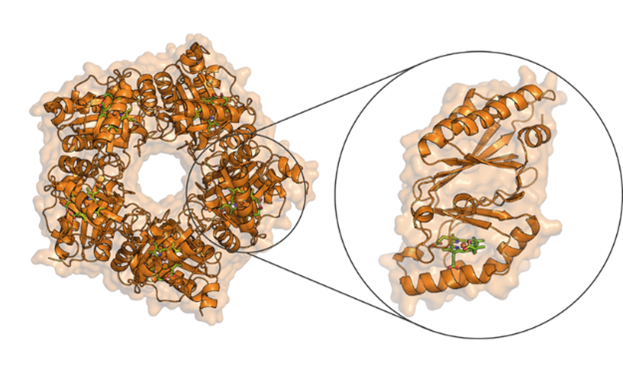Structural studies of actinobacterial coproheme decarboxylase (ChdC) from Corynebacterium diphtheriae
SUPERVISOR: Stefan HOFBAUER
Background.
Until 2015, the “classical” protoporphyrin-dependent heme biosynthesis pathway was believed to be the main route to synthesize heme in the bacterial world, next to an alternative pathway, which is utilized by Archaea and denitrifying bacteria. With the identification of the coproporphyrin-dependent heme biosynthesis pathway (Dailey et al., 2015), which utilizes coproheme decarboxylase (ChdC) to catalyse the ultimate step in mainly monoderm bacteria (Dailey et al., 2015), a new scientific chapter was opened. ChdCs lack a homologous human enzyme. Since many pathogenic monoderm bacteria already display multiple resistances to common antibiotics, ChdCs are a promising target for the development of urgently needed novel antibacterial substances. Moreover, the ability of pathogens to obtain and process (heme) iron is a crucial factor of their virulence and survival (Sheldon and Heinrichs, 2015).
ChdCs catalyse the decarboxylation of two propionate groups of iron coproporphyrin III (coproheme) to form heme b, which is the final product of heme biosynthesis. In this reaction coproheme is a redox-active substrate. The reaction mechanism of this enzyme is not fully understood yet. Most biochemical and biophysical studies on purified ChdCs were performed on enzymes from Firmicutes (Clade 1), e.g. ChdCs from Listeria monocytogenes and Staphylococcus aureus (Hofbauer et al., 2016a;Hofbauer et al., 2016b;Celis et al., 2017). ChdC from Corynebacterium diphtheriae belongs phylogenetically to Clade 2 and exhibits significant differences to Clade 1 ChdCs concerning reaction kinetics and its predicted active site architecture (Pfanzagl et al., 2018). It is known that ChdCs depend on an essential, catalytic tyrosine residue, and a 90°-reorientation of the intermediate porphyrin species is facilitated during turnover (Michlits et al., 2020;Sebastiani et al., 2021). In this project we aim to study the structure-function relationships of ChdC from Corynebacterium diphtheriae in order to understand the missing pieces of the reaction mechanism, which includes the active site architecture of the product (heme b) bound form and kinetic characterization of the second decarboxylation reaction, yielding heme b.

Aims and methods.
Homopentameric ChdC from Corynebacterium diphtheriae (wild-type and variants) will be heterologously expressed in E. coli. Based on recently solved X-ray structures from other ChdCs and structural models, site-directed mutagenesis of distal and proximal amino acids will be performed. Emphasis will be placed on amino acids involved in coproheme binding and oxidation, redox regulation and internal electron transfer.
Wild-type and mutant proteins will be characterized by a broad set of biochemical/physical methods including (i) X-ray crystallography, (ii) high-resolution Cryo-EM studies (in cooperation with Dominika BOREK, UTSouthwestern Medical Center, Dallas), (iii) detailed spectral analysis (UV-vis, electron paramagnetic resonance and resonance Raman spectroscopy) of proteins, and protein-based radicals in different redox- and spin-states (in cooperation with Giulietta SMULEVICH from the Department of Chemistry, University of Florence, Italy), (iv) time-resolved multi-mixing UV-Vis stopped-flow studies in order to analyse the kinetics of interconversion and spectroscopic features of relevant redox intermediates, (v) spectroelectrochemical studies (in cooperation with Gianantonio BATTISTUZZI from the Department of Chemistry, University of Modena and Reggio Emilia, Italy).
These methods will provide valuable insight into the mechanism of coproheme decarboxylation. Proposed pathways will be analysed by classical and ab initio molecular dynamics simulations (in cooperation with OOSTENBRINK).
Celis, A.I., Gauss, G.H., Streit, B.R., Shisler, K., Moraski, G.C., Rodgers, K.R., Lukat-Rodgers, G.S., Peters, J.W., and Dubois, J.L. (2017). Structure-Based Mechanism for Oxidative Decarboxylation Reactions Mediated by Amino Acids and Heme Propionates in Coproheme Decarboxylase (HemQ). J Am Chem Soc 139, 1900-1911.
Dailey, H.A., Gerdes, S., Dailey, T.A., Burch, J.S., and Phillips, J.D. (2015). Noncanonical coproporphyrin-dependent bacterial heme biosynthesis pathway that does not use protoporphyrin. Proc Natl Acad Sci U S A 112, 2210-2215.
Hofbauer, S., Dalla Sega, M., Scheiblbrandner, S., Jandova, Z., Schaffner, I., Mlynek, G., Djinović-Carugo, K., Battistuzzi, G., Furtmüller, P.G., Oostenbrink, C., and Obinger, C. (2016a). Chemistry and Molecular Dynamics Simulations of Heme b-HemQ and Coproheme-HemQ. Biochemistry 55, 5398-5412.
Hofbauer, S., Mlynek, G., Milazzo, L., Pühringer, D., Maresch, D., Schaffner, I., Furtmüller, P.G., Smulevich, G., Djinović-Carugo, K., and Obinger, C. (2016b). Hydrogen peroxide-mediated conversion of coproheme to heme b by HemQ-lessons from the first crystal structure and kinetic studies. FEBS J, 283, 4386-4401.
Michlits, H., Lier, B., Pfanzagl, V., Djinović-Carugo, K., Furtmüller, P.G., Oostenbrink, C., Obinger, C., and Hofbauer, S. (2020). Actinobacterial coproheme decarboxylases use histidine as distal base to promote Compound I formation. ACS Catal 10, 5405-5413.
Pfanzagl, V., Holcik, L., Maresch, D., Gorgone, G., Michlits, H., Furtmüller, P.G., and Hofbauer, S. (2018). Coproheme decarboxylases - Phylogenetic prediction versus biochemical experiments. Arch Biochem Biophys 640, 27-36.
Sebastiani, F., Michlits, H., Lier, B., Becucci, M., Furtmüller, P.G., Oostenbrink, C., Obinger, C., Hofbauer, S., and Smulevich, G. (2021). Reaction intermediate rotation during the decarboxylation of coproheme to heme b in C. diphtheriae. Biophys J 120, 3600-3614.
Sheldon, J.R., and Heinrichs, D.E. (2015). Recent developments in understanding the iron acquisition strategies of gram positive pathogens. FEMS Microbiol Rev 39, 592-630.
